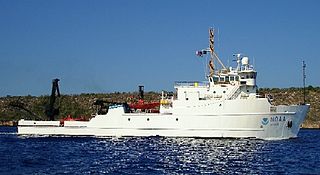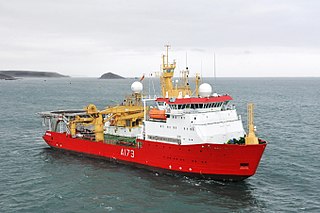| History | |
|---|---|
| Name: | Mermaid Sapphire |
| Owner: | Mermaid Offshore Services Ltd. [1] |
| Port of registry: | Panama City, Panama [1] |
| Builder: | PT Jaya Asiatic Shipyard, Batam, Indonesia [1] |
| Launched: | 2009 [1] |
| Identification: |
|
| Status: | In service |
| General characteristics | |
| Type: | ROV & air diving support vessel [1] |
| Tonnage: | |
| Length: | 63 m (206 ft 8 in) o/a [1] |
| Beam: | 15 m (49 ft 3 in) [1] |
| Draught: | 5 m (16 ft 5 in) [1] |
| Depth: | 6.1 m (20 ft 0 in) [1] |
| Installed power: | 2 × 470 kW (630 hp) Volvo + 1 × 99 kW (133 hp) Volvo emergency generator [1] |
| Propulsion: |
|
| Boats & landing craft carried: | SMD Quasar Compact ROV [1] |
| Crew: | 60 [1] |
Mermaid Sapphire is an offshore multipurpose vessel. [2] Built in 2009, the ship is used for mostly research and undersea work.
She is a purpose-built ABS Classed DP2 ROV and air diving support vessel, designed for operation of dual deepwater work-class ROV's (Quasar Compact or Triton XLX) plus optional inspection-class ROV. The ROV's are installed on a dedicated raised deck level, leaving all back deck space for project equipment. Mermaid Sapphire is also equipped with state-of-the-art subsea inspection data acquisition and data management systems. A 23-tonne knuckleboom crane, and auxiliary 5-tonne crane are also installed. [1]

A remotely operated underwater vehicle is a tethered underwater mobile device. This meaning is different from remote control vehicles operating on land or in the air. ROVs are unoccupied, usually highly maneuverable, and operated by a crew either aboard a vessel/floating platform or on proximate land. They are common in deep water industries such as offshore hydrocarbon extraction. They are linked to a host ship by a neutrally buoyant tether or, often when working in rough conditions or in deeper water, a load-carrying umbilical cable is used along with a tether management system (TMS). The TMS is either a garage-like device which contains the ROV during lowering through the splash zone or, on larger work-class ROVs, a separate assembly which sits on top of the ROV. The purpose of the TMS is to lengthen and shorten the tether so the effect of cable drag where there are underwater currents is minimized. The umbilical cable is an armored cable that contains a group of electrical conductors and fiber optics that carry electric power, video, and data signals between the operator and the TMS. Where used, the TMS then relays the signals and power for the ROV down the tether cable. Once at the ROV, the electric power is distributed between the components of the ROV. However, in high-power applications, most of the electric power drives a high-power electric motor which drives a hydraulic pump. The pump is then used for propulsion and to power equipment such as torque tools and manipulator arms where electric motors would be too difficult to implement subsea. Most ROVs are equipped with at least a video camera and lights. Additional equipment is commonly added to expand the vehicle's capabilities. These may include sonars, magnetometers, a still camera, a manipulator or cutting arm, water samplers, and instruments that measure water clarity, water temperature, water density, sound velocity, light penetration, and temperature. Also optical-stereo cameras have been mounted on ROVs in order to improve the pilots' perception of the underwater scenario.
A data hub is a collection of data from multiple sources organized for distribution, sharing, and often subsetting and sharing. Generally this data distribution is in the form of a hub and spoke architecture.

A knuckleboom crane appears similar to a standard crane, except that the boom articulates at the 'knuckle' near the middle, letting it fold back like a finger. This provides a compact size for storage and manoeuvring.
On March 26, 2012, she carried Deepsea Challenger to the Challenger Deep where the first solo dive to the bottom of the trench was made. [3]

Deepsea Challenger is a 7.3-metre (24 ft) deep-diving submersible designed to reach the bottom of Challenger Deep, the deepest-known point on Earth. On 26 March 2012, Canadian film director James Cameron piloted the craft to accomplish this goal in the second manned dive reaching the Challenger Deep. Built in Sydney, Australia by the research and design company Acheron Project Pty Ltd, Deepsea Challenger includes scientific sampling equipment and high-definition 3-D cameras; it reached the ocean's deepest point after two hours and 36 minutes of descent from the surface.

The Challenger Deep is the deepest known point in the Earth's seabed hydrosphere, with a depth of 10,898 to 10,916 m by direct measurement from submersibles and slightly more by sonar bathymetry. It is located in the Pacific Ocean, at the southern end of the Mariana Trench near the Mariana Islands group. The Challenger Deep is a relatively small slot-shaped depression in the bottom of a considerably larger crescent-shaped oceanic trench, which itself is an unusually deep feature in the ocean floor. The Challenger Deep's bottom is about 11 km (7 mi) long and 1.6 km (1 mi) wide, with gently sloping sides. The closest land to the Challenger Deep is Fais Island, 287 km (178 mi) southwest, and Guam, 304 km (189 mi) to the northeast. It is located in the ocean territory of the Federated States of Micronesia, 1.6 km (1 mi) from its border with ocean territory associated with Guam.

The Mariana Trench or Marianas Trench is located in the western Pacific Ocean approximately 200 kilometres (124 mi) east of the Mariana Islands, and has the deepest natural trench in the world. It is a crescent-shaped trough in the Earth's crust averaging about 2,550 km (1,580 mi) long and 69 km (43 mi) wide. The maximum known depth is 10,994 metres (36,070 ft) at the southern end of a small slot-shaped valley in its floor known as the Challenger Deep. However, some unrepeated measurements place the deepest portion at 11,034 metres (36,201 ft). For comparison: if Mount Everest were dropped into the trench at this point, its peak would still be over two kilometres (1.2 mi) under water.










